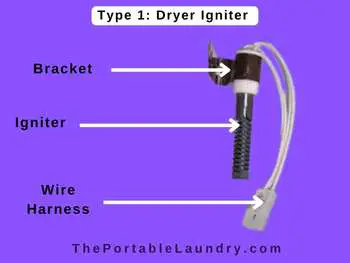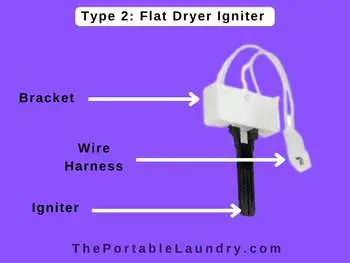Depending on your gas dryer’s model type, the igniter can be accessed by disassembling the back or the front panel. You will find the igniter near the gas valve in the form of a small round metal part. Use a putty knife or other flat tool to carefully disconnect the wires that are attached to the igniter and replace them with the new one.
Reverse the steps to reconnect everything back to its place and run a test cycle to make sure the igniter works as expected.
Key Takeaways
- When a gas dryer is turned on, the igniter provides a spark, which when it comes into contact with the gas, warms the air moving toward the drum to dry your clothing.
- Before replacing the igniters, always check them to make sure that there are no other problems with the related parts.
- Always refer to the user manual to locate the igniter by removing the correct access panels. This will ensure that you move in the right direction from the beginning.
- Check the igniter by using a multimeter as well as by pressing the button that triggers the ignition.
Table of Contents
What is an igniter in a clothes dryer?
An igniter can be found in a clothes dryer that uses gas (natural gas or propane gas) to generate heat. It is responsible for providing the initial spark that ignites the gas in order to heat up the air inside the dryer. It is a tiny, round-shaped component found near the gas valve.
There are usually two types of igniters that are commonly used in gas dryers, i.e., electrodes and glow-bar.
An electrode-type ignitor consists of two metal electrodes that are separated by a small gap.
When electricity is passed through the electrodes, it creates a spark that ignites the gas.
A glow-bar type ignitor works similarly, but instead of two electrodes, it contains a glowing wire that heats up and ignites the gas when electricity is passed through it.
Most modern gas clothes dryers use a glow-bar type ignitor because they are less likely to create sparks that can ignite flammable items that may be present in the dryer (such as lint).
However, electrode-type ignitors are sometimes used in commercial dryers because they tend to be more durable and last longer than glow-bar-type ignitors.
How does a dryer igniter look like?
Here’s a quick diagram of how an igniter in a dryer looks like:
Type 1:

Type 2:

Where is the igniter located in a gas dryer?
On most gas dryers, the igniter is located behind the bottom part of the front panel, and in some dryers, it is accessible behind the rear panel.
Igniters are typically fixed near the gas valve, and if you’re having trouble finding it, simply refer to your dryer’s manual or call the manufacturer’s helpline.
How to replace the igniter in a clothes dryer?
Most home clothes dryers use an electrical igniter to light the gas.
Over time, these igniters can become corroded or otherwise damaged and will need an inspection or replacement.
You can replace them at home with basic tools and some patience.
Before beginning, make sure to get a suitable replacement igniter for your dryer and keep your dryer’s user manual handy.
Instructions to replace the Igniter
Follow the below instructions to replace the igniter in your gas dryer.
Step 1: Disconnect the supplies
Unplug the dryer from the power outlet and disconnect any gas lines if applicable.
Move the machine away from the back wall for better access.
Step 2: Remove the correct access panel
Disassemble the access panel to access the igniter.
In order to do so, remove the screws or clips that keep the access panel intact.
Depending on the model of the dryer, the igniter may be located near the front or back of the dryer.
Note: Refer to the user manual before proceeding to remove the correct panel of the dryer. For some dryers, you may have to remove the entire drum to gain better access to the igniter. To remove it, you will need to detach the suspension system that holds the drum. Unbolt the drum and pull it carefully off the dryer.
Step 3: Disconnect the igniter’s wires to disassemble
Once the access panel is removed, place it aside carefully.
Now, use a putty knife or other flat tool to disconnect the wires that are attached to the igniter carefully.
Note: In order to know where the wires go when it’s time to rejoin them, you can label the wires. With the wires disconnected, you should be able to remove the old igniter.
Step 4: Dryer Igniter Test
Visually examine the igniter before replacing it to check for any corrosion or aging-related damage indicators.
There is a good chance that the igniters are in good shape, and it is something else that may be problematic, such as loose or damaged wires.
If the wires around the igniter appear good, another problem could be that the igniter isn’t receiving enough power.
Moreover, there could be something wrong with the connection between the igniter and the dryer.
Test it with a multimeter to see if it’s getting enough power, and if it is not, then the problem could be with the gas valve, thermostat, or fuse.
In order to use a multimeter, connect one multimeter probe to each ignition terminal and take the readings.
If you get a reading and the needle in the multimeter moves, it means that there is continuity, and it’s likely that the igniter is good. However, if there is no change on the dial or reading, then this means there is no continuity and you will need to replace the igniter.
With that said, there may be scenarios where the electrical continuity is good but the igniter itself has worn out (meaning the igniter itself is damaged). In such cases, you may need a replacement.
Another way to inspect an igniter is to check if there is no lint or other debris blocking it.
If the igniter is clean, then try pressing the button or switch that ignites the gas.
If the igniter does not produce a spark or if the spark is very weak, then it may need to be replaced.
Step 5: Fix the replacement igniter
Place the new igniter in its place and connect the wires carefully and correctly. This should be easy if you have labeled the wires.
Step 6: Reconnect the dryer
Reconnect the access panel by screwing it firmly into place.
Finally, connect the gas supply to the dryer.
Now run a test cycle to check if the igniter sparks and see if your dryer is able to generate heat like before.
Symptoms of a damaged gas igniter
- Gas dryer fails to heat up or takes a significantly longer time to dry clothes.
- No visible glow or spark from the igniter during the drying cycle.
- Gas dryer produces a weak or intermittent spark, indicating a faulty igniter.
- Unusual noises or rattling coming from the igniter area, suggesting physical damage.
- Visibly cracked or broken igniter element when inspecting the igniter component.
- Igniter shows no continuity or infinite resistance when tested with a multimeter.
- The gas dryer does not respond to the ignition button or switch, indicating igniter failure.
- Igniter emits a burning or burnt odor, signaling possible overheating or damage.
- Gas dryer fails to ignite consistently, resulting in incomplete or unsuccessful drying cycles.
- Visible signs of corrosion or wear on the igniter element, indicating potential damage.
Identifying the type of igniter used in a gas dryer
To identify the type of igniter used in different models of gas dryers, follow these steps:
Step 1: Check the User Manual
Refer to the user manual or documentation that came with your gas dryer.
It should provide information about the type of igniter installed in the specific model.
Step 2: Visual Inspection Inspect the igniter carefully
Electrode-type igniters usually have two metal electrodes separated by a small gap.
Glow-bar type igniters have glowing wire, so look for these distinguishing features to determine the type.
Step 3: Identify Igniter Connector
Locate the igniter connector, which is a set of wires connected to the igniter. This connector provides power to the igniter.
Step 4: Power Off the Dryer
Before proceeding with any testing, unplug the dryer from the power outlet to ensure your safety.
Step 5: Use a Multimeter
A multimeter is a tool used to measure voltage, resistance, and continuity. Set the multimeter to the resistance or ohms setting (Ω).
Step 6: Test Electrode-Type and glow bar type Igniter
For electrode-type igniters:
- Disconnect the igniter connector.
- Place the multimeter probes on the two metal electrodes of the igniter
- If the multimeter shows a reading close to zero ohms or continuity, the igniter is functional. If the reading is infinity or has no continuity, the igniter is faulty and needs replacement.
Test Glow-Bar Type Igniters:
- Disconnect the igniter connector.
- Place one multimeter probe on the igniter’s glowing wire and the other on any metal part of the dryer for grounding.
- If the multimeter shows a reading close to zero ohms or continuity, the igniter is functional.
- If the reading is infinity or no continuity, the igniter is faulty and requires replacement.
Step 7: Interpret the Results
- A reading close to zero ohms or continuity indicates that the igniter is functional and should work correctly.
- An infinity reading or no continuity suggests that the igniter is faulty and needs replacement.
A word of caution
Always refer to your specific gas dryer’s manual and safety guidelines before attempting any repairs. If you are unsure about the process or lack experience, it is recommended to seek the assistance of a professional appliance repair technician. Gas appliance repairs can be hazardous, so safety precautions must be followed at all times.
Final Thoughts
An igniter is one of the tiniest parts of a gas dryer responsible for triggering the ignition.
When all of a sudden, your gas dryer stops heating, it becomes difficult to pinpoint the exact cause unless you disassemble the front or back panel to access the igniter and the cables around it.
So, it becomes important to thoroughly check the cable around it with a multimeter to ensure that there is nothing wrong with the cables or fuse.
Also, before replacing the igniter, inspect the gas supplies, valves, and power supply.
If you are not comfortable replacing the igniter yourself, you can always contact a professional appliance repair person to take care of it for you.
Lastly, take safety precautions when dealing with any kind of appliance, especially, that uses gas.
Frequently Asked Questions
What is the cost of replacing an igniter on a dryer?
The cost of replacing an igniter in a gas dryer is anywhere between $90 and $250.
What causes a dryer igniter failure?
If the ignitor fails to glow, check for a blown fuse or cut-off thermostat. If the ignitor glows but fails to ignite a flame inside the burner assembly, check for a blown high-limit thermostat, thermal fuse, or gas supply.
Why is my gas dryer not getting hot?
A tripped circuit breaker, a clogged vent, and a lack of gas flow are some of the common reasons why a gas dryer is not getting hot. Furthermore, a damaged thermal fuse or even a broken heating element may cause the same problem.
Why does my dryer smell like gas?
If your dryer smells like gas, the first thing you should do is open all the doors and windows to ventilate the room. Then, check for any gas leaks in the dryer. If you cannot find any leaks, the smell could be coming from the lint trap. In such cases, clean the lint trap and run the dryer on a test cycle. If the problem persists, call a professional.
You May Also Like
- 14 Reasons Why Your Dryer is Squeaking & Solutions
- Washer Dryer: 27 Questions Answered
- How To Replace The Power Cord In A Washing Machine?
- How to replace agitator dogs in a washing machine?
- How to replace the timer switch in a Washing Machine?
- How to replace the tub seal in a top load washing machine?
- How to replace the buzzer in a washing machine?
- How to Replace Washing Machine Capacitor? (Step-by-Step)
- How To Replace Tub-To-Pump Hose In Washing Machine?
- How To Replace The Drain Hose In Washing Machine?
- How To Replace Washing Machine PCB Board?
- How to Replace The Outer Panels Of A Washing Machine?
- How To Replace The Door Of Your Top Load Washer?

